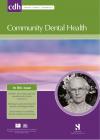Community Dental Health

- Cover Date:
- December 2011
- Print ISSN:
- 0265 539X
- Vol:
- 28
- Issue:
- 4
Incisor trauma in a Turkish preschool population: Prevalence and socio-economic risk factors
Objective: This study aimed to assess the prevalence of traumatic injuries of the primary incisors in preschool children from 2 to 5 years old in South-Eastern Anatolia, Turkey. Additionally, the relationship between traumatic dental injuries, parents’ education level, family income, size of incisal overjet and the presence of anterior open bite were examined. Basic research design: A cross-sectional survey Clinical settings: Data were collected through oral examinations and structured interviews, and included socio-economic indicators. Participants: A total of 727 children of both genders were included in the study. 122 of these children were aged 2; 183 aged 3; 178 aged 4 and 186 aged 5. Results: The prevalence of dental injuries was 8.0% (n=58). The highest frequency of trauma in the primary teeth was observed at the age of 4. Boys experienced more dental injuries than girls, 12.2% and 4.0%, respectively. The most common crown fracture was in enamel only (57%) followed by crown fracture of enamel and dentin (19%). Conclusion: The prevalence of dental injuries in Turkish preschool children was very low. The children with incisal overjet greater than 5mm and anterior open bite experienced more dental injuries in primary teeth than their counterparts with normal occlusion. Socio-economic indicators were not statistically significantly associated with the occurrence of traumatic dental injuries.
Key words: traumatic dental injury; socio-economic indicators; primary teeth; overjet; anterior open bite
- Article Price
- £15.00
- Institution Article Price
- £
- Page Start
- 308
- Page End
- 312
- Authors
- E.C. Tümen, Ö. Adıgüzel, S. Kaya, E. Uysal, İ. Yavuz, E. Özdemir, F. Atakul
Articles from this issue
- Title
- Pg. Start
- Pg. End
- Why has oral health promotion and prevention failed children requiring general anaesthesia for dental extractions?
- 255
- 258
- Predictors of utilisation of dental care services in a nationally representative sample of adults
- 269
- 273
- Applicability of both dentist and patient perceptions of dentists’ explanations to the evaluation of dentist–patient communication
- 274
- 279
- Evaluation of a preventive program based on caries risk among mentally challenged children using the Cariogram model
- 286
- 291
- The effect of a modified fluoride toothpaste technique on buccal enamel caries in adults with high caries prevalence: a 2-year clinical trial
- 292
- 296
- Association of clinical oral health status with self-rated oral health and GOHAI in Japanese adults
- 297
- 300
- Prevalence of periodontopathogens in a black Brazilian secluded community matched with a black urban population
- 301
- 304
- Incisor trauma in a Turkish preschool population: Prevalence and socio-economic risk factors
- 308
- 312
- Malocclusion and orthodontic treatment need measured by the Dental Aesthetic Index and its association with dental caries in Indian schoolchildren
- 313
- 316
